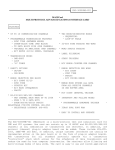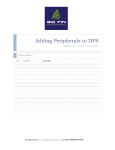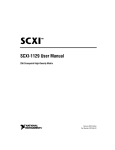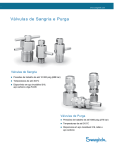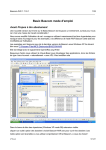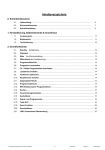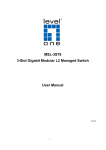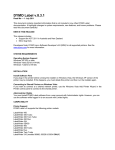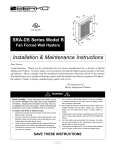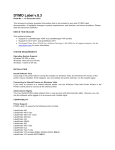Download Senior Assembler & Simulator user manual
Transcript
Senior Assembler & Simulator user manual September 4, 2008 Contents 1 Senior assembler 1.1 Command line syntax . . . . . 1.2 Assembler source file structure 1.2.1 Reserved words . . . . . 1.2.2 Mnemonics . . . . . . . 1.2.3 Identifiers . . . . . . . . 1.2.4 Labels . . . . . . . . . . 1.2.5 Comments . . . . . . . . 1.2.6 Numbers . . . . . . . . 1.2.7 Directives . . . . . . . . 1.3 Special I/O ports . . . . . . . . . . . . . . . . . . . . . . . . . . . . . . . . . . . . . . . . . . . . . . . . 2 Senior simulator 2.1 Command line syntax . . . . . . . . . 2.2 Simulator commands . . . . . . . . . . 2.2.1 h/? — print help . . . . . . . . 2.2.2 p — print registers . . . . . . . 2.2.3 l — list program . . . . . . . . 2.2.4 r — run a number of cycles . . 2.2.5 d0 — dump data memory 0 . . 2.2.6 d1 — dump data memory 1 . . 2.2.7 g — run until CTRL-C pressed 2.2.8 e — toggle event . . . . . . . . 2.2.9 q — quit . . . . . . . . . . . . . . . . . . . . . . . . . . . . . . . . . . . . . . . . . . . . . . . . . . . . . . . . . . . . . . . . . . . . . . . . . . . . . . . . . . . . . . . . . . . . . . . . . . . . . . . . . . . . . . . . . . . . . . . . . . . . . . . . . . . . . . . . . . . . . . . . . . . . . . . . . . . . . . . . . . . . . . . . . . . . . . . . . . . . . . . . . . . . . . . . . . . . . . . . . . . . . . . . . . . . . . . . . . . . . . . . . . . . . . . . . . . . . . . . . . . . . . . . . . . . . . . . . . . . . . . . . . . . . . . . . . . . . . . . . . . . . . . . . . . . . . . . . . . . . . . . . . . . . . . . . . . . . . . . . . . . . . . . . . . . . . . . . . . . . . . . . . . . . . . . . . . . . . . . . . . . . . . . . . . . . . . . . . . . . . . . . . . . . . . . . . . . . . . . . . . . . . . . . . . . . . . . . . . . . 5 5 6 7 7 7 7 8 8 8 11 . . . . . . . . . . . 13 13 14 14 14 15 16 16 17 17 17 17 3 Contents 4 Contents 1 Senior assembler The Senior assembler is an assembler for the Senior DSP assembly language. The assembler uses three passes. In the first pass all source code, except undefined identifiers and labels, is translated to a hex format. In the second pass all remaining identifiers and labels are translated (if possible) and inserted into the right place in the hex code. In the third pass, hex file output is generated provided there were no errors in the previous passes. The hex file output is a text file for use with the Senior simulator only. The following sections in this chapter will describe the use of the Senior assembler and the source file structure. The Senior assembler instruction set is described in a separate document. 1.1 Command line syntax The assembler command line uses the following syntax: srasm infile [outfile ] where srasm is the name of the Senior assembler program, infile is the name of the assembler source file and outfile is the optional name of the output hex file. If no name is given for the output hex file one will be generated using the name of the infile as the base with the extension .hex added. For instance if the infile is named test1.asm the outfile will be named test1.hex. The output hex file will always be written in the same directory as the input source file, unless a certain path is specified in the outfile parameter. For instance, running the command: > srasm test1.asm out/test01 Senior assembler Assembled successfully into ’out/test01’ will generate the file test01 (without .hex extension) in the out directory (provided it exists). Running the command: > srasm src/test1.asm Senior assembler Assembled successfully into ’src/test1.hex’ will generate the file test1.hex in the same directory as the infile test1.asm. 5 1.2. ASSEMBLER SOURCE FILE STRUCTURE CHAPTER 1. SENIOR ASSEMBLER 1.2 Assembler source file structure The assembler source file typically consists of several sections. Usually there is first a section with defines and aliases declaring names of constants, registers and such for later use in the code. There are four memory spaces (ram0, rom0, ram1 and code) defining where definitions and code eventually end up. Here is an example of a source file: ; === main.asm === ; This is the main program .alias #define port1 .ram1 .skip sp 0x0011 ar3 128 stack .align 1024 .code #include "output.asm" main set call main_loop call call jump sp,stack stream_init ;initialize stack pointer ;initialize stream read_header layer2_decode main_loop .rom0 table_bitrate .dw 0, -1,-1,-1,1, -1,2, 3, 4, 5, 6, 7, 8, 9, 10 table_C .scale 2.0 .dfu 1.33333333333, 1.60000000000, 1.14285714286, 1.77777777777 table_D .scale 1.0 .df 0.06250000000, 0.03125000000, 0.01562500000, 0.00781250000 Concerning indentation, label definitions MUST reside at the beginning of a line, hash directives (#), dot directives (.) and comments MAY start at the beginning of a line 6 CHAPTER 1. SENIOR ASSEMBLER 1.2. ASSEMBLER SOURCE FILE STRUCTURE and everything else MUST NOT start at the beginning of a line. The various parts of the source code structure is explained in the following sections. 1.2.1 Reserved words Reserved words are words that can not be used for anything else but their designated purpose. These are typically all the mnemonics (instructions and such), names of registers, accumulators, scale factors, etc, in short everything that is declared in the assembler by default. For instance the word call (for the instruction call) is reserved and can not be used as an identifier or a label, but for instance the words call or call4 are not reserved and can be used freely. 1.2.2 Mnemonics Mnemonics are typically the instruction words and its various options and operators. An assembler source line, with an instruction, always start with the instruction itself followed by its arguments, if any. The exact syntax for all instructions and its options, the instruction set, is described in a separate document. All mnemonics must be written in the source code using lowercase lettering. 1.2.3 Identifiers In the assembler source file context, identifiers are names that refer to something typically defined by the programmer. A label, a constant or the definition of a register. The assembler lines .alias #define port1 sp 0x0011 ar3 would define the identifiers sp and port1 for reference to the address register ar3 and the constant 0x0011 respectively, for later use in the code. Identifiers must use the syntax [a-zA-Z ][a-zA-Z0-9 ]*. This means they must start with a lowercase or uppercase letter from a to z or the underscore sign ( ), then followed by a mix of any number of (0 or more) lowercase or uppercase letters a to z, digits 0 to 9 or underscore signs. For instance, these are acceptable identifiers: start1, data , AC9 xy, and these are not acceptable: 7level, -track, acer~. 1.2.4 Labels Labels are identifiers and must follow the rules as such (see previous section). Label definitions MUST reside at the beginning of a line and MUST NOT be followed by anything else for the remainder of the line, except comments. 7 1.2. ASSEMBLER SOURCE FILE STRUCTURE CHAPTER 1. SENIOR ASSEMBLER 1.2.5 Comments Comments may reside anywhere in the code. A comment is initiated by the semicolon character (;) and is active until the end of the line. 1.2.6 Numbers Numbers can be either integer numbers or floating point numbers. Integer numbers can be entered using the decimal, hexadecimal or binary base. Decimal number are entered just the way they are, with an optional leading minus sign (-) if it is a negative number. Hexadecimal numbers are initiated using either 0x or $ and binary numbers start with %. For instance, these are decimal numbers: -17, 32700, and these are hexadecimal numbers: 0x3A7F, $9001, and this is a binary number: %10010110. Floating point numbers can be entered in a decimal form only using the syntax [0-9]+[.][0-9]+, that is starting with one or several digits followed by a decimal point followed by one or several digits. Negative floating point numbers may be entered with a leading minus sign (-). For instance, these are floating point numbers: 3.14159265359, -0.33333333333. 1.2.7 Directives The assembler makes use of cpp (C pre processor) before processing the assembly source code. Hence cpp must be available in the search path when running the assembler. Cpp makes it possible to use some of its pre processor directives in the assembly code. #include The #include directive is a cpp directive. It includes another source file exactly as it is in the place of the #include directive. This way it is possible to divide a project into several assembly source files and include them wherever needed. The #include directive takes a file name within quotation marks as its only argument, like this: #include "init.asm" #define The #define directive defines identifiers for constants. Look at the section Identifiers above for the definition of identifiers. A constant identifier may be defined like this: #define port1 0x0011 .code The .code directive is one of four memory space directives. It sets an internal memory space pointer to direct the following code generation to the program memory space. This program memory space is used for actual program content, that is instructions. The directive is valid until another memory space directive occurs. 8 CHAPTER 1. SENIOR ASSEMBLER 1.2. ASSEMBLER SOURCE FILE STRUCTURE .ram0 The .ram0 directive is one of four memory space directives. It sets an internal memory space pointer to direct the following code generation to the first part of data memory 0. This directive is typically used together with the .skip directive (see below) to reserve larger sets of RAM memory. For instance the following code: .ram0 array4 .skip 128 would reserve 128 data words in data memory 0 for access with the label array4. The directive is valid until another memory space directive occurs. .rom0 The .rom0 directive is one of four memory space directives. It sets an internal memory space pointer to direct the following code generation to the second part of data memory 0. This directive is typically used for ROM table content. It is stored in the hex output file together with the rest of the generated program content and loaded into the simulator at start. Used together with the .dw, .df or .dfu directives it is possible to generate ROM table data, for instance like this: .rom0 .dw .dfu .df 0, -1,-1,-1,1, -1,2, 3, 4, 5, 6, 7, 8, 9, 10 1.33333333333, 1.60000000000, 1.14285714286, 1.77777777777 0.06250000000, -0.03125000000, 0.01562500000, -0.00781250000 The directive is valid until another memory space directive occurs. .ram1 The .ram1 directive is one of four memory space directives. It sets an internal memory space pointer to direct the following code generation to data memory 1. This directive is typically used together with the .skip directive (see below) to reserve larger sets of RAM memory. For instance the following code: .ram1 table7 .skip 12000 would reserve 12000 data words in data memory 1 for access with the label table7. The directive is valid until another memory space directive occurs. 9 1.2. ASSEMBLER SOURCE FILE STRUCTURE CHAPTER 1. SENIOR ASSEMBLER .skip The .skip directive increments the internal memory space pointer for the current memory space by the number of its one and only argument. Skipping, thus reserving, that amount of memory. This directive only makes sense in the ram0 or the ram1 memory space. .align The .align directive takes one positive number as its argument. That argument will adjust the current memory space pointer to the next multiple of the argument number. For instance, if the current memory space pointer is at 1000 and the directive .align 256 is set, the memory space pointer would be adjusted to 1024, since 1024 is divisible by 256. If using .align 4 nothing will happen, since 1000 is already divisible by 4. .alias The .alias directive defines identifiers for already existing definitions of registers, accumulators, other identifiers and such. It takes two comma separated identifier arguments. The first one must not be previously defined while the second one must be previously defined. For instance, the following: .alias sp ar3 would define the identifier sp to be the very same as the address register ar3. .scale The .scale directive affects the way floating point numbers are stored. The directive takes one positive floating point number as its only argument. The directive will set a range for floating point numbers to be stored. For instance, the following: .scale 2.0 would set the range [-2.0,2.0[ for signed floating point numbers and the range [0,2.0[ for unsigned floating point numbers. The directive is valid until another .scale directive is set. Any floating point number outside the range will be saturated to within the range, with a given warning. The default .scale directive value is 1.0. .dw The .dw directive will store a 16 bit integer number at the memory space pointer in the current memory space. The directive takes a comma separated list of signed or unsigned constants as its argument. It is only useful in the rom0 memory space. It may be used for instance like this: .rom0 .dw 10 7, -3, data3, $3F12 ; data3 is a previously defined constant CHAPTER 1. SENIOR ASSEMBLER 1.3. SPECIAL I/O PORTS .df The .df directive will store a signed floating point number at the memory space pointer in the current memory space. The directive takes a comma separated list of signed floating point constants as its argument. It is only useful in the rom0 memory space. Each value will be divided by the scale factor (set by the .scale directive) and then converted to a binary representation with a sign bit and 15 fractional bits. This 16 bit value is finally stored in memory. If the value does not fit this representation it will be saturated. It may be used for instance like this: .rom0 .scale 2.0 .df 0.0, 0.5, -1.0, 1.0, -2.0, 2.0 which will be equivalent with the following code: .rom0 .dw $0000, $2000, $C000, $4000, $8000, $7FFF Note that the sixth value (2.0) has been saturated. .dfu The .dfu directive is similar to the .df directive. The difference is that .dfu uses an unsigned representation with 16 fractional bits. It may be used for instance like this: .rom0 .scale 2.0 .dfu 0.0, 0.5, 1.0, 1.5, 2.0 which will be equivalent with the following code: .rom0 .dw $0000, $4000, $8000, $C000, $FFFF Note that the fifth value (2.0) has been saturated. 1.3 Special I/O ports There are four I/O ports that have special meaning for the assembler and simulator. They are the following: Address $0010 $0011 $0012 $0013 I/O in out out out Description Read data from the external file "IOS0010" Write data to the external file "IOS0011" Stop simulation and exit simulator Stop simulation, same as pressing CTRL-c 11 1.3. SPECIAL I/O PORTS CHAPTER 1. SENIOR ASSEMBLER These I/O ports are either in or out only, to be used with the instructions in or out respectively. Using the instruction: in r14,$0010 will read the next data from the file ”IOS0010” to general register r14. The file ”IOS0010” must be a plain text file with 16 bit hexadecimal values, one value per line. It may look something like this: 0087 7a71 bb27 005e 308d 006d 0022 Using the instruction: out $0011,r21 will write data from the general register r21 to the file ”IOS0011”. The format of the file ”IOS0011” is the same as for the file ”IOS0010” above. Using the instruction: out $0012,r0 will stop the simulation and exit the simulator. This is useful when using external scripts and makefiles for running several simulations sequentially without human intervention. The contents of the source register (r0) will be ignored. Using the instruction: out $0013,r0 will stop the simulation and return to the simulator prompt, thus remaining in the simulator environment. This is useful when there is a need to inspect processor status (registers, flags, stack, memories, etc) at a certain point in the program after running at full speed. Think of it as a break point. The contents of the source register (r0) will be ignored. 12 2 Senior simulator The Senior simulator is a simulator for the Senior DSP. Although the Senior DSP has a pipelined architecture the simulator operates from a programmers point of view, so that each instruction is seemingly executed immediately, though all cycle events are kept track of and executed accordingly. In other words, the Senior simulator is not a fully true pipeline cycle simulator. 2.1 Command line syntax The simulator command line uses the following syntax: srsim [-r] [-p pm size ] [-0 dm0 size ] [-1 dm1 size ] program where srsim is the name of the Senior simulator program and program is the filename of the program to simulate, the file produced as output from the Senior assembler. All other arguments are optional and work as follows: Option -r -p -0 -1 Description run program directly when loaded set size for program memory set size for data memory 0 set size for data memory 1 Maximum value --65536 65536 65536 Default value --65536 65536 65536 For instance, running the command: > srsim -p 4096 test1.hex Senior simulator Allocated 4096 words for program memory Allocated 65536 words for data memory 0 Allocated 65536 words for data memory 1 Read 924 words to program memory sim> will set program memory size to 4096, load the program test1.hex to program memory and wait for command input at the sim> prompt. OBSERVE, all sizes for program memory and data memories must be large enough to hold its designated content or there will be a memory access violation. When using the option -r, simulation may be aborted by pressing CTRL-c which will also exit the simulator. 13 2.2. SIMULATOR COMMANDS CHAPTER 2. SENIOR SIMULATOR 2.2 Simulator commands The simulator has a few ”in house” commands (explained below) for use when simulating. It is always possible to repeat the last command by pressing CTRL-d . 2.2.1 h/? — print help Print a list of available commands. It should look something like this: sim> h Senior simulator ---------------------------------------p print registers r <n> run <n> cycles d0 [n] dump dm0 from address [n] d1 [n] dump dm1 from address [n] g go, until CTRL-C e toggle event l list program around pc h/? display this help q quit ---------------------------------------sim> 2.2.2 p — print registers Print the contents of all 32 general registers, all 32 special registers, all 4 accumulators, the contents of the hardware stack, the settings of all flags, the value of the program counter, the hardware stack pointer and the cycle counter. It should look something like this: sim> p r: 0000 0040 0000 0000 0000w0000 0000 0000 0000 0000 0000 0000 0000w0000 0000 0000 0000 0000 0000 0000 0000 0000 0000 0000 0000 0000 0000 0000 0000 0000 0000 0000 sr: 0000 0000 0000 0000 0000 0000 0000 0000 0000 0000 3F12r0000 0000 0000 0000 0000 0000 0000 0000 0000 0000 0000 0000 0000 0000 0000 0000 0000 0000 0000 0000 0000 acr: 0000000000 0000000000 0000000000 0000000000 hwstack: 14 CHAPTER 2. SENIOR SIMULATOR 2.2. SIMULATOR COMMANDS 0000 0000 0000 0000 0000 0000 0000 0000 0000 0000 0000 0000 0000 0000 0000 0000 flags: MV:0 MS:0 MN:0 MZ:0 AV:0 AC:1 AN:0 AZ:0 pc: hwsp: cc: 0003 0 3 test1.asm:14: set r7, #$3F7A sim> Lastly, the next source code line to be executed may be printed. Printed is the source code file name, line number and then the actual source code line. The simulator is not aware of the source code file location, so for this to work the source code file has to be in the same directory as from where simulator is started. After each and one of the general and special registers there may be one of the characters r or w printed in either lowercase or uppercase. A lowercase r or w signifies this register is scheduled for a reading or writing, respectively, at a later cycle. An uppercase R or W signifies this register is to be read or written, respectively, at the current cycle. 2.2.3 l — list program List the source code program around the current program counter address. Some addresses before and some after the current program counter will be printed. The current source code line to be executed is notified with an arrow, ->. It should look something like this: sim> l -> set r5,2 lsr lsr lsr lsr lsr set and and and and and st0 cmp move.eq r1,r8,12 r2,r8,10 r3,r8,9 r4,r8,6 r6,r8,4 r8,1 r1,15 r2,3 r3,1 r4,3 r6,3 (ar2++),r1 3,r4 r5,r8 ; bitrate ; mode_single_channel ; channels (1 or 2) sim> The simulator is not aware of the source code file location, so for this to work the source code file has to be in the same directory as from where the simulator is started. 15 2.2. SIMULATOR COMMANDS CHAPTER 2. SENIOR SIMULATOR 2.2.4 r — run a number of cycles Run a specified number of cycles. This command takes one argument, an integer number, specifying how many cycles to run. After running the specified number of cycles the p command, print registers, is executed. It should look something like this: sim> r 4 Simulating 4 cycle(s):[100..104[ r: 0040 000aW0000w0000w0001w0002 0a04 0000 0001 0001 0000 0000 0000 0000 0000 0000 0000 0000 0000 0000 0000 0000 0000 0000 0000 0000 0000 0000 0000 0000 0000 0000 sr: 0000 0000 0004 007e 0000 0000 0000 0000 0000 0000 0000w0001 0000 0000 0000 0000 0000 0000 0000 0000 0000 0000 0000 0000 0000 0000 0000 0000 0000 0000 0000 0000 acr: 0000000000 0000000000 0000000000 0000000000 hwstack: 0008 00b5 0000 0000 0000 0000 0000 0000 0000 0000 0000 0000 0000 0000 0000 0000 flags: MV:0 MS:0 MN:0 MZ:0 AV:0 AC:0 AN:0 AZ:0 pc: hwsp: cc: 00c2 1 104 test1.asm:79: and r6,3 sim> 2.2.5 d0 — dump data memory 0 Dump (print) 128 address contents, starting from a specified address, from data memory 0. This command takes one optional argument, an integer number, specifying from what address to start dumping. If no argument is given, dumping will continue from after the last address previously dumped. It should look something like this: sim> d0 33368 8258: 9592 8276 8260: 6a6e 7d8a 8268: 9592 8276 8270: 7fd9 6dca 8278: aa0a e0e6 8280: f9b8 be32 8288: 5ed7 7c2a 16 8276 7d8a 83d6 41ce 1f1a 9236 8583 9592 6a6e a129 0648 55f6 8027 aecc b8e3 471d d4e1 c946 7885 8c4a f374 e707 18f9 12c8 9930 7e9d b3c0 3c57 18f9 e707 4c40 8163 66d0 ed38 70e3 471d b8e3 73b6 877b 36ba 2b1f 7f62 CHAPTER 2. SENIOR SIMULATOR 8290: 8298: 82a0: 82a8: 82b0: 82b8: 82c0: 82c8: 82d0: sim> 62f2 5134 9d0e aecc 1f1a 6dca 7c2a 41ce cf04 2528 7a7d dad8 8583 c946 2b1f 73b6 7885 89be dad8 7a7d 2528 877b 8c4a d4e1 36ba 89be 89be 9d0e 5134 62f2 be32 83d6 9236 e0e6 cf04 cf04 809e 0c8c 7f62 12c8 b3c0 8163 9930 30fc 30fc 2.2. SIMULATOR COMMANDS 8f1d c3a9 70e3 5ed7 0648 aa0a 8027 7642 7642 c3a9 8f1d 3c57 7fd9 55f6 f9b8 a129 7642 7642 0c8c 809e f374 66d0 7e9d 4c40 ed38 30fc 30fc 2.2.6 d1 — dump data memory 1 Dump (print) 128 address contents, starting from a specified address, from data memory 1. This command works in the same way as the command d0, but from data memory 1. See above. 2.2.7 g — run until CTRL-C pressed Run continously until CTRL-c is pressed. Having run the command and then pressed CTRL-c it should look something like this: sim> g Running...(break with CTRL-C)... Execution aborted at PC:626, CYCLE:3892040 sim> 2.2.8 e — toggle event Toggle event messaging on or off. Some events during simulation like saturation from calculations or delay slot jump activation, may be notified by event messaging. It can be useful when stepping through a program but may be annoying when running at full speed. Toggling event messaging should look something like this: sim> e Event is on sim> e Event is off sim> Event Messaging is off by default. 2.2.9 q — quit Quit and exit the simulator. 17

















